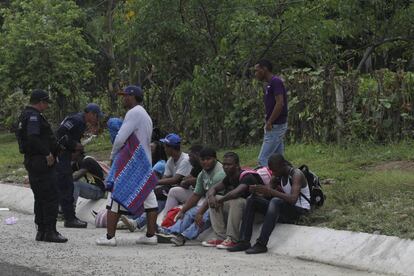The forgotten border of Mexico, where 522 migrants are detained a day
Government plan to boost security in country’s south having negative effect, say rights groups
After the rancorous US election campaign, and President-elect Donald Trump’s oft-repeated promise to build a wall between the United States and Mexico, international attention has very much been on that northern border. The situation along Mexico’s porous 1,000-kilometer southern frontier with Guatemala, meanwhile, has made far fewer headlines.

But in 2015 alone, Mexican authorities detained 190,366 people on that border who were trying to reach the United States – that is a total of 522 people a day and is the highest figure seen since 2005, with the Mexican government’s Programa Frontera Sur (Southern Border Program) largely responsible for this spike.
Under the initiative, which was designed to stem the flow of people passing through on their way to the US, there has been a jump in the number of operations aimed at capturing immigrants entering Mexico.
These detainees remain deprived of their liberty in centers run by the National Institute of Migration (INM) for months on end, according to a new report by the Mexican migrant rights group Sin Fronteras (Without Borders).
What do these people have to lose if their life is in danger in their own countries? Sin Fronteras report
“In the middle of 2015, the result was clear: the program meant there were more Central American migrants being detained in Mexico than in the United States,” says the group in its Detention without Exception report.
The Frontera Sur program was launched in 2014 by Mexican President Enrique Peña Nieto together with the then-president of Guatemala, Otto Pérez Molina. Enrique Peña at the time made assurances that the aim of the program was to safeguard the rights of migrants entering the country and boost security in the region as a whole. To ensure an “orderly flow” at the border, people crossing would be presented with either a cross-border worker pass or a card for regional visitors.
But migrant-rights groups have accused the new program of making it even more dangerous for people traveling without documents by forcing people smugglers to push their activities further underground.
The Sin Fronteras organization argues that the implementation of the Southern Border Program against a backdrop of high levels of violence across Mexico has seen migrants putting their welfare in the hands of the hitmen and gangs who control the country’s illegal immigration networks – sometimes in collaboration with the authorities. In early October, authorities in the southern Mexican state of Chiapas exposed an illegal immigration network operated by municipal police and headed up by the brother of the mayor of the town of Chiapa de Corzo.
There were more Central American migrants being detained in Mexico than in the United States in 2015
The report by Sin Fronteras stresses that the number of migrants entering the country from the south continues to rise despite the expansion and militarization of operations targeting this group, with authors noting that people who are “seeking a better life” are “capable of confronting even the most sophisticated systems of control.”
“What do these people have to lose if their right to life is in constant danger in their own countries?” the report asks.
From 2000 to 2015, a total of 2.1 million undocumented migrants were detained in Mexico and placed in detention centers.
“During this process, these people faced a series of violations of their human rights, which range from a lack of information as they were processed through the system, to physical and mental health problems and limited access to resources to help them mount a defense,” said United Nations Commission on Human Rights representative Alán García at an event marking the release of the Sin Fronteras report.
English version by George Mills.
Tu suscripción se está usando en otro dispositivo
¿Quieres añadir otro usuario a tu suscripción?
Si continúas leyendo en este dispositivo, no se podrá leer en el otro.
FlechaTu suscripción se está usando en otro dispositivo y solo puedes acceder a EL PAÍS desde un dispositivo a la vez.
Si quieres compartir tu cuenta, cambia tu suscripción a la modalidad Premium, así podrás añadir otro usuario. Cada uno accederá con su propia cuenta de email, lo que os permitirá personalizar vuestra experiencia en EL PAÍS.
¿Tienes una suscripción de empresa? Accede aquí para contratar más cuentas.
En el caso de no saber quién está usando tu cuenta, te recomendamos cambiar tu contraseña aquí.
Si decides continuar compartiendo tu cuenta, este mensaje se mostrará en tu dispositivo y en el de la otra persona que está usando tu cuenta de forma indefinida, afectando a tu experiencia de lectura. Puedes consultar aquí los términos y condiciones de la suscripción digital.










































